Trip Details
We enjoyed our trip to Iceland in May 08 so much that we
decided to go back again this year - from July 23rd to August 10th,
2009. Last year we spent just a few days in Reykjavík and
the surrounding area. This year, we decided to drive around the entire
island. For those who haven't had
a chance to go to Iceland - we heartily recommend it! Feel free to ask
us questions - Karen is kitten@golden.net
and Neil is neil@treheima.ca, petersons@treheima.ca goes to both of us.
Icelandair
flies from a number of places in North America to a number of places in
Europe and laying over in Iceland is easy since they use Iceland as
their hub and don't charge extra for taking time off to stay in
Iceland. There are a number of tourist sites that can help
you plan your trip including TripAdvisor,
Visit Iceland,
My
Reykjavík Info, Visit
Reykjavík, Icetourist,
and various regional websites we'll link to throughout the text below.
The trip had three main parts:
- Departing Canada, arriving in Iceland, spending time in
Reykjavík (July 23rd to 25th)
- Traveling the West Fjörðs and the ring
road (July 26th to
August 6)
- Time in Reykjavík and the trip home (August 6 to
10th)
Before we begin talking about the trip it is important to
introduce our traveling companion.
Snorri Steveson is a shared
resource, carved by Steve from DARC.
Snorri made his appearance in the group at the
beginning of July and we decided to take him with us just for
fun. He came to Iceland with us on this trip and
then we passed him off to Marcus and Jo for a trip to Denmark and
England via a short stop in Iceland.
Friday, July 24th
As with last year we took the last day off work to finalize
packing. First, Snorri had to say goodbye to Karen's
.... err, our garden.
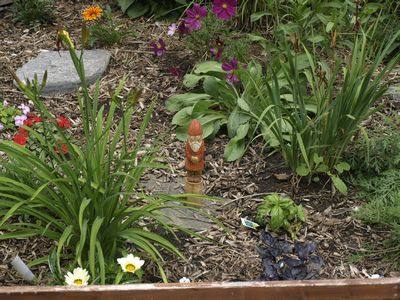
Airways Transit
picked us up in the afternoon for the run to the airport. In planning
this trip, we noticed that Icelandair's
'economy comfort class' had come down in price from where it was just
after they introduced it, shortly after last
year's trip. Needless to say, we jumped at the chance for a
more comfortable seat for the 5 hour flight. The seat came
with some perks, including lounge access at the airport, which is quite
a pleasant way to spend the time after clearing customs.
Here we find Snorri in the airport lounge while we wait for
the plane. Snorri is visiting the DARC website.
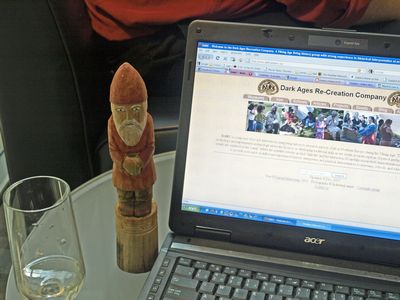
The plane left Toronto around 9:00 pm in the evening. The
flight is just over 5 hours in actual time, but there is a 4 hour time
difference in the summer. So our bodies thought it was 2:30 am when we
arrived, but
the clocks in Iceland read 6:30 am so no full night's worth of sleep.
Upon landing we collected our luggage and picked up a car
from "Saga Car
Rental" who had bought out SG car rental, with whom we had
rented last year. Apparently there were many such buyouts happening
during the rough year from Iceland's banking collapse. With car in
hand, we headed out to the Blue
Lagoon, via
a short detour to scope out the location of the new Vikingaheimar
museum. The Blue Lagoon is a great way to attempt to recover from
jetlag. It worked decently well enough last year but not quite as well
this year. While we were soaking, we found that there was a strong
enough northerly wind to create cold currents in the water.
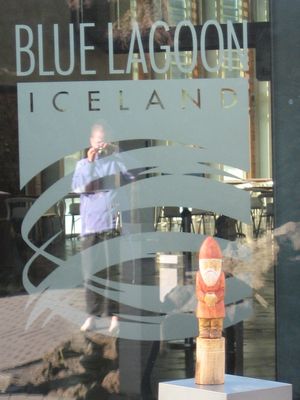
After our warm soak, we headed into town to see if our room at the
Guesthouse was ready. We returned to the Guesthouse Eirikur Rauði
run by Runar and Edda. It's a nice, inexpensive place to stay
when you are in town for a day or two and it's sort of homey.
Our room was ready, so we grabbed a couple of hours of nap
and then headed into downtown Reykjavík to grab lunch at Icelandic Fish and Chips.
Since it was a nice sunny day we also wandered up the shore
to see the sun sculpture, Sólfar. Karen was disappointed
with last year's pictures because the day was overcast. This year we
had lovely bright sunlight, which really highlights this wonderful
sculpture.
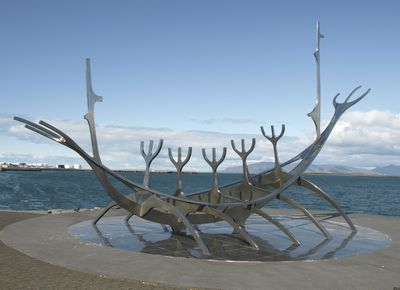
Another shot that is a little more whimsically artistic.
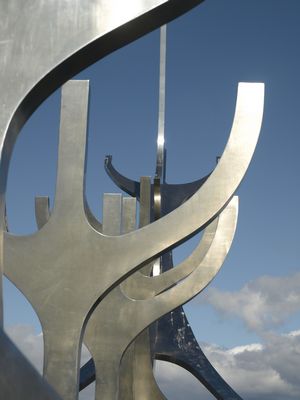
One from Neil of the intrepid photographer doing her thing.
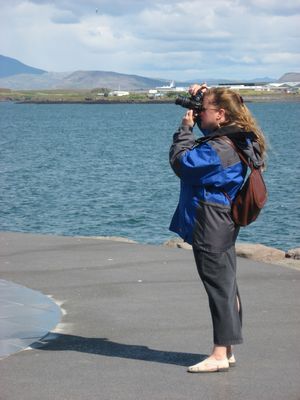
Hallgrímskirkja
was even more covered in scaffolding than last year so we skipped the
trip up the tower to look around. If you haven't been to
Reykjavik before it is worth the small amount of money to head up into
the bell tower and look around - but watch out for the wind.
Karen wanted something
simple like pizza so Neil found Eldsmiðan
and we tried some of these pizzas. Neil had the Trio del mare
- ekki olifur (no olives). Neil was so proud of getting those last two
words pronounced correctly enough that the waitress just nodded.
This
seafood pizza was quite good - wonderfully spiced. Neil washed his down
with Thule beer - an Icelandic beer that he hadn't tried yet.
It's not a bad beer, rather Canadian in flavour, noticeable bitters.
Karen made something up from the 'pick your own toppings' and regretted
it when 'nuts' turned out to be peanuts. No beer for the jetlagged
girl. A little more wandering around on Laugavegur, the main
shopping
street, and then back
to the guesthouse to crash.
Karen had a hard time recovering from jetlag this year. She
feels that perhaps she just isn't as hardy as she was last year. Jet
lag had her bouncing up and down all day long - lost appetite,
grumpiness, chills. It's no fun. A good night's sleep did wonders for
her though and she was fine the next morning.
Saturday, July 25 - Botanical gardens and Vikingaheimar
We went to the botanical gardens in Reykjavík and
found
a few things to photograph. Karen is an avid gardener, so she was quite
delighted by the Gardens and took many pictures. We had stopped here
last year as well but it was cold and rainy, and since we stopped much
earlier in the season (late May) there was little to see. This year
just two months later plants were everywhere. Delphiniums which you
couldn't see in May were over six feet tall in July.
A pretty rock garden....
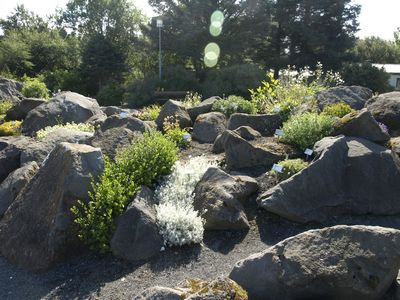
A humble bumble bee doing it's thing...
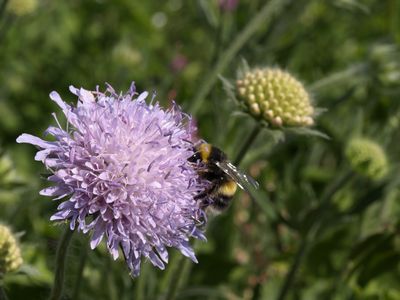
Lots and lots of pretty flowers....
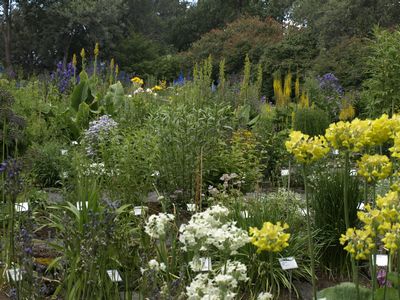
This bird ....
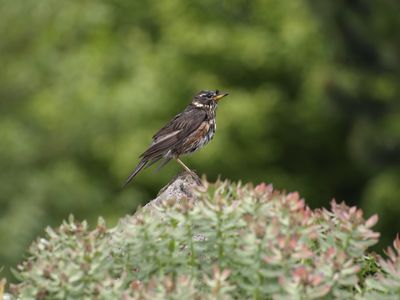
......splashing around in this lovely water garden.
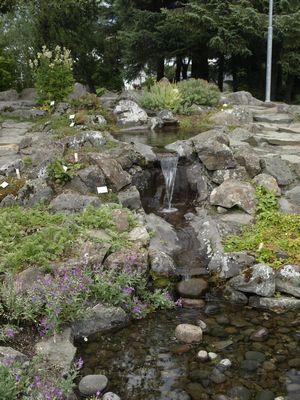
There were also children aplenty pulling the leaves and sometimes the
plants out of the water feature in the botanical garden cafe (not
pictured to protect their destructive little identities) and dropping
their plastic cars in the pond. The cafe here seems to be a regular
place for the locals to hang out as the menus were heavy on Icelandic
as was pretty much all of the talking we heard. The gardens
themselves are much better in the sun - it rained last year when we
visited. Amazing plant growth compared to the end of May last year. It
was also interesting noticing what will grow here and how it
grows. Several things seem to do better here than at home, probably because of the significantly longer hours of sunlight.
It's also interesting that despite the Botanical Gardens being
such a hotspot for Icelanders, very few of them seem to have the
gardening 'bug' that we do in Canada. Maybe there's a bit more of it in
the suburbs then there is in the city's downtown.
Snorri came to visit the new Vikingaheimar
museum with us. Vikingaheimar is built around the
Íslendingur, a replica Viking ship. It's very difficult to get a picture of the whole ship, because inside a building, one can't back far enough away to get it all in one frame without hitting a wall.
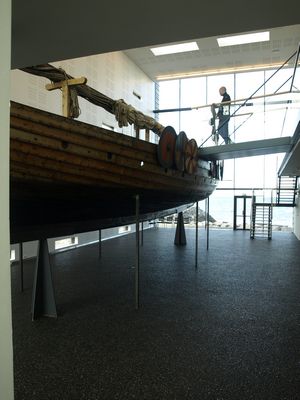
Neil went into more detail about the museum in this post
on the DARC blog.
This is a new museum housing Íslendingur which was sailed
over to L'Anse Aux Meadows, Newfoundland in the year 2000 to celebrate
the 1000 year anniversary of the discovery of North America by the
Norse. This new museum is a little sparse for content but that isn't
terribly surprising with the current economic climate in Iceland. It is
well laid out, providing wonderful visibility into the boat - viewing
areas exist to look down on it or walk underneath it. It's also
possible for some tourist groups like schoolchildren to walk into the
ship as well. The supporting rooms have reasonable content, the layout
gives you leisure to examine the artefacts and a very nice mural, and
there is room to expand the collection as time and money allow. They
allowed pictures, and listed artefact numbers in most of the displays
with bilingual text about the item. The text had a good balance of
overall context and some information about the particular artefact.
Overall, it's well worth the time and money to visit.
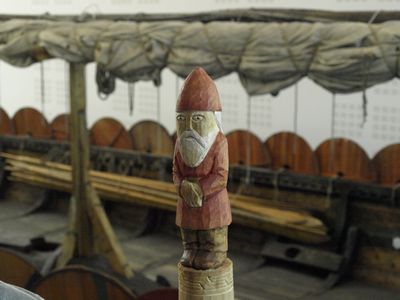
Back in Reykjavík, we did a little more shopping before the
shops started to close. As with last year, we discovered that in
Reykjavík, there are cats everywhere. This kitty was found
in a wool shop downtown. Karen was very tempted by the colours of one
sweater but it didn't fit, and had the patterning at both wrist and
waist, which she doesn't like in the traditional Icelandic sweaters.
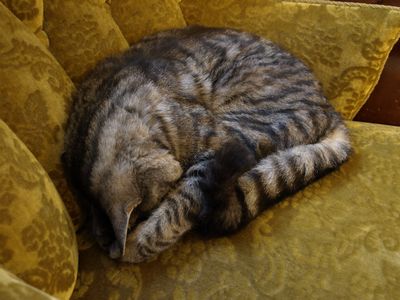
We were also looking for a place to buy Ipod accessories for Karen's
Ipod. She'd brought it to have travel music available when we headed
out on the ring road, but forgot to bring a recharger cable, or a
'connect to the car' cable. We arrived at the Mac store an hour after
it closed and discovered that it isn't open on Sundays.
We had dinner at the Tapas
Barinn. Wonderful! Delightful! Sangria! Karen loves tapas as
a style more and more as she tries it in various places, and in
Iceland, with its wide variety of products from the sea, it is even
more delicious. You can try a wide variety of things from the
menu because the portions are so tiny, the arrangements on the plate
are often visually exciting. You can stop when you're full and not feel
like you're wasting anything, and you can stretch the meal as long or
as short as you wish into the evening as a result.
We shared most dishes: grilled giant scallops with grilled
tomatoes (tomatoes make a delightful
addition to scallops and it was spiced rather well),
pan-fried monkfish with lobster sauce (lobster sauce... real good),
minke whale with cranberry sauce (cranberry sauce good... whale is
interesting.... kinda gamey), smoked puffin with blueberry 'brennivn'
sauce (the puffin is an odd colour and taste - good, but odd), grilled
lobster on a stick with zaffron sauce (Karen doesn't think that is
saffron sauce, the menu had otherwise perfect English, was in fact all
in
English, but she wouldn't recognize saffron if she tasted it, so we
don't
know for sure), grilled lamb Sanfaina with mint sauce (lamb good, no
mint
flavour that could be detected), monkfish and lobster marinated in
garlic with zaffron sauce. And for dessert - Neil had Creme Catalona
(Creme Caramel with some minor flavour changes), and Karen had
chocolate
cake with berry compote and whipped cream. Yes, that is pretty much
opposite
our
usual choices..... and Karen did steal a chunk of his creme caramel.
Sunday, July 26 - Leaving Reykjavík, Eiriksstaðir,
Sytikkisholmur
Ragnarr the cat visited us again briefly this morning before we checked
out of the
Guesthouse Eirikur
Rauði. See Ragnarr in last
year's photos.
Sunday saw us driving to Sytikkisholmur
via Eiriksstaðir. Mixed gravel and paved roads running
up and down BIG hills and along fjörðs - lots of fun.
We saw a lot of sheep, multiple saga valleys, and big hills.
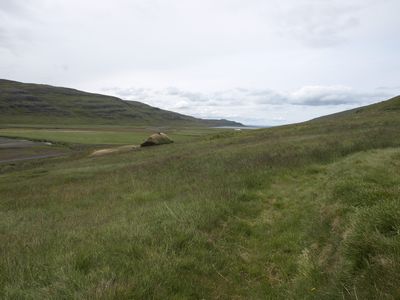
Eiriksstaðir is
a small museum on the site of what is thought to be Erik the Red's
first married homestead. It was occupied for only 10-20 years before he
had to move on "due to some killings". The museum itself has a small
staff shack, a set of washrooms, a half dozen full sized poster boards
with the site history in four languages (Icelandic, English, German,
and one of the scandinavian languages). Just slightly uphill from the
signs are the actual remains - covered over again but with the wall
outline shown as at L'Anse Aux Meadows.
Neil tries to give us some perspective on just how small the house is -
4 m by 12 m.
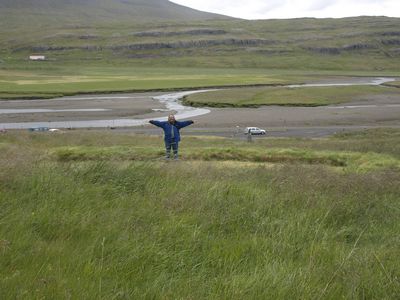
A few yards off to one side is the reconstructed house where you find
the re-enactors.
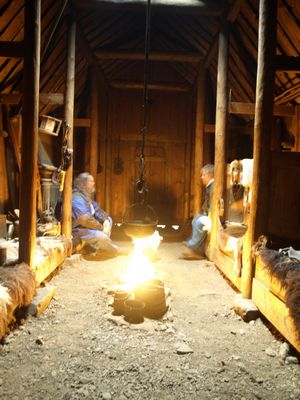
The re-enactment presentation is entirely in third person story
telling. They talk through the story of Erik and Leifr - birth, exile,
new lands, all of it. The hall is fairly nice, and like the houses at
L'Anse Aux Meadows it cuts out the outside wind-noise perfectly. Neil
noted they have too much stuff - multiple spears, a sword, multiple
axes, many shields, sheepskins everywhere, bric a brac tucked in every
corner, and lots of clothes on the walls. Karen noticed the remains of
a Kubb game outside in the 'yard'. Kubb has been dated to the mid _20th
century_ - there is no evidence at all, anywhere, that it dates back to
the Viking Age.
This kind of historical misinformation was something that we
encountered everywhere that re-enactors were involved in historical
sites, all over Iceland. It's quite frustrating. Neil wants to tell
folks that a re-enactor program is not necessarily a bad thing, that it
does add a depth and dimensionality that really makes the visit
worthwhile, but recommends that you know your history and bring salt
shakers.
This nice lady (Helga Ágústsdóttir)
humoured the crazy Canuck and held Snorri still against the wind so
Karen could take his picture.
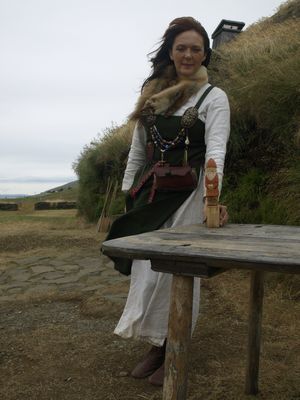
In Stykkishólmur, we stayed at the Hotel
Stykkishólmur, which had a tricky internet service
that only worked when we were nowhere near a power outlet. For dinner
we both had a lovely lobster soup creamy with coniac and panfried
langoustines, followed by
the fish of the day (arctic char) with mixed veggies, potatoes, and
white
wine sauce for Karen (the fish
was
a bit dry but mixed with the veggies added moisture), and
monkfish and langoustines with veggies and red wine glaze for Neil
(quite nice,
monkfish is so textured). Karen had
apple cake with caramel sauce and vanilla ice cream (delic!)
and Neil had skyrpanacotta with dates and orange gel (dates were fairly
sweet but the
skyr was sharp so it was a nice contrast. Not a flavour combination he
would have thought to try himself which is always nice).
Monday, July 27 - A ferry
into the West Fjörðs, and
Ísafjörður
On Monday, we got up early enough to get some gas and to be at
the ferry to the West
Fjörðs at 8:20am. Karen was up even earlier
then she had hoped because the bed was too hard, and sunrise happens
here at 4 bloody am. We have yet to meet any form of accommodation here
that understands the concept of blackout cloth or blinds or those of us
afflicted with light activated brains.
Neil answered a directional question from another tourist just before
we hit the ferry - in French! The oddest things happen when you are on
vacation. We stopped for gas before getting on the ferry so Karen took the opportunity to look for salt and vinegar potato chips, a favourite snack - no luck.
The ferry ride was fun, if a bit windy. By the by, the wind is all out
of the north so far, which provides a wind chill factor that drops the temperature. Don't get
me wrong - in Iceland, outdoors is almost always better then indoors,
but it can take some effort to get acclimated.
Loading the vehicle onto the boat was interesting. They really
jam the vehicles in tight on the ferry - passengers have to get off and
walk onto the boat which is important because after you park they
couldn't open that door. The ground guides really know their stuff
'though because Neil didn't see any scrapes. Neil tried to
take pictures of some of the many birds that inhabit Breiðafjörður
while Karen hid from the wind just around the corner.
Breiðafjörður is home to over 50 different
breeding species of birds.
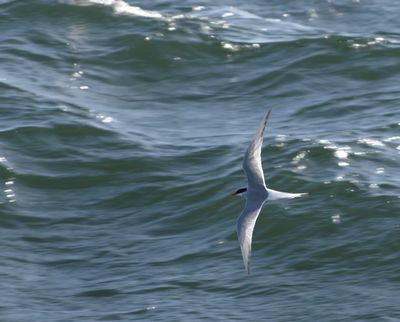
When we landed at Brjanslækur in the West
Fjörðs, we turned right and drove 6km up road 62 to
Flokalunda for lunch. Lunch was simple and good food. Karen had a ham and cheese sandwich and made her first encounter with the complete lack of vinegar as a condiment for french fries. It was pleasant to get out of the wind for a bit.
And then the fun began.
Where 'fun' becomes synonymous with words like 'terrifying' and phrases
like 'oh my freaking god' and 'Oh god, oh god, we're all going to die!'
Serenity
fans should know that last one. Neil tried "I am a leaf on the wind"
just once and I had to remind him that the character did die right
after that line!
Let's just say the drive to Ísafjörður
was.... a tad.... interesting. Lots of blind curves, blind hills, sharp
drops from large cliffs too close to the road for comfort, steep
inclines (up and down) - and did we mention narrow and roughly unpaved?
We took road 60 to Dynjandi/Þingeyri. The first indication of
what is to come is the steep upward climb on an old gravel road. The
tourist brochure had a note from the cops "speed limits are for your
safety - it's your vacation, what is your hurry?". Now in Canada, they
might _say_ something like that, but the speed limits all have a
different purpose. Here they mean "If you have driven on gravel or dirt
roads most of you life, have a 4x4, and don't mind single lane bridges,
blind hills, crazy curves, blind hills ON crazy curves, small lanes and
steep cliffs then go right ahead and drive at the limit, otherwise you
will want to drive slower". Neil drove slower.
Problem areas are well posted with speed advisories. At one point while
driving in a sequence of switch backs down a scree slope on a dirt road
with no railings we went around one 180 turn marked with "20 kph" as
its' limit, Neil went slower.... At another point on a particularly
interesting curve around the side of a mountain with a lovely
fjorð a few hundred feet down (and 6 inches from the side of
the car) we actually saw a very short guard rail - the only one we saw.
Neil managed to not actually leave nail marks in the steering wheel.
Once you get to Dynjandi, the
drive into Ísafjorður gets much better. Neil
actually got up to 80 kph at quite a few points when he wasn't braking
for sheep.We got pictures but no way do the pictures convey the sheer
scale of this place.
We took a brief break from the driving terror to visit, and climb
several terraces up, around Dynjandi.
This group of waterfalls is 186 m tall in total and is comprised of
many different smaller waterfalls on the way down, many of which are
individually named. At the main fall off the cliff, the top spread is
30 m, widening to 60 m at it's base.
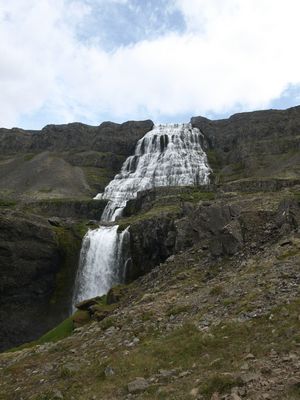
Just to give you some perspective on that height - see that road just
in front of the fjorð? And the little brown circle (aka the
parking lot)? You can't really see the cars from this close to the top.
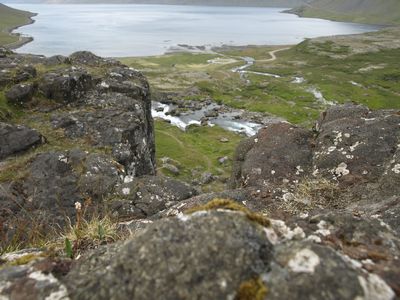
And here's one of us in front of the main fall, courtesy of fellow
tourists returning the favour.
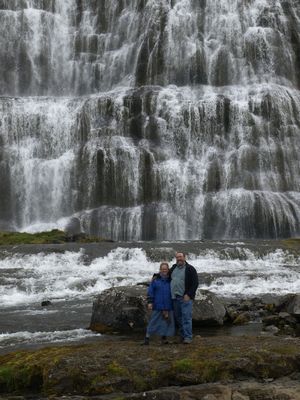
So this was Monday, and we lived to arrive in
Ísafjörður. But Karen was so tired that
even though we had great internet and a wonderful meal, she went to bed
quite early, and even slept through sunrise at 4 bloody am, right until
a rather decent 8ish am. We spent the night at Hotel
Ísafjörður. The receptionist was
very helpful with postcards for the nieces and nephews. We had a decent
meal in
the hotel's house restaurant. Neil had asparagus soup, pan fried
puffin in blueberry sauce with
potatoes, and a skyr mousse with fruit and raspberry coulis
- puffin is very much a 'red' meat, stronger flavour then cornish game
hen. Karen had no appetizer, being very very tired, and went straight
into the house special of salt cod au gratin over garlic
flavoured potatoes, and she also had the skyr mousse for dessert.
Tuesday, July 28 - finally Holmavik (sort of)
Tuesday we wandered around Ísafjorður in
the morning. We found a nice bakery for breakfast but
Ísafjörður is otherwise a sleepy little
fishing town where the stores don't open
until at least noon. We stopped at the local grocery store for food on the way out since we weren't sure we'd be near a town around lunch time. Karen looked for salt and vinegar potato chips again - still no luck. Lots of yummy skyr 'though, and some very very good licorce bits.
The afternoon saw our intrepid couple driving in zigzags
around these annoying obstacles called fjörðs - no
straight lines here! Better roads than yesterday with only a few
stretches of unpaved roads and much less steepness. The steepest
incline we saw today was 12%. Driving along a 'road' marked by raised
gravel and little yellow wands on each side, through the fog, across
the top of a mountain was a new experience for Neil. Not really scary,
but just one of those "you are here" moments.
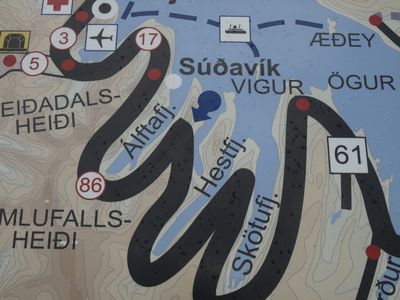
As we left Ísafjorður, we had to pause briefly to
let these sheep wander across the road. They seemed to be coming toward
us in our lane, but thankfully they swerved in time to avoid a
collision.
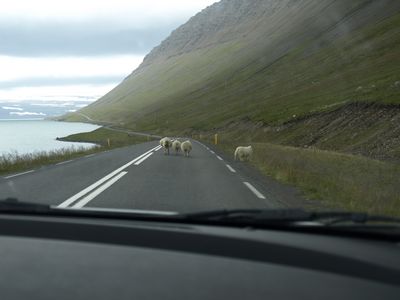
We stopped briefly on the other side of the fjord in order to take a picture of Ísafjorður, our sleepy little host of the night before. Good thing that mountain stayed in it's place, eh?
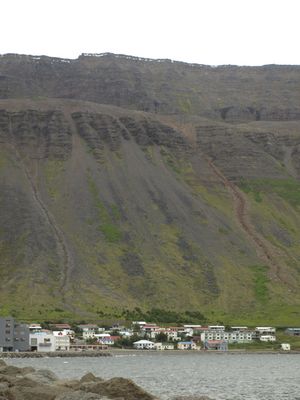
We made no special stops along the way this day, but the road was much
much better then the day before and there was lots of interesting
scenery.

We spent the night at the Hotel
Laugarholl - a pretty plain country hotel
outside of Holmavik. Actually, we missed the turnoff for the hotel, drove into Holmavik and asked at the tourist information spot, and got directed to drive back a bit.
The Hotel Laugarholl was WAY out in the country, on increasingly smaller and less paved roads - in the middle of a beautiful valley. No internet in the room. No phone service on the
blackberry. Weak internet in the lobby. Dinner was fine but
simple. Mushroom soup, flounder in a cream sauce with potatoes on one
side and rice on the other, and home made banana ice cream with
chocolate sauce for desert for both of us. The only choice actually was
fish or meat. When we were ready for a little after dinner dip, the
public pool next door had just closed and was in the process of being
drained for cleaning. Darn it. Also, right beside the hotel
is also the Sorcerer's
Cottage which is a part of the Witchcraft and Sorcery Museum
project. This part of the project is focused on how the poor
lived in a recreated sod cottage. The poor were largely the victims of
witchcraft persecution. It was closed but we did walk around
the outside.
Wednesday, July 29th - Blönduós
Karen continued her unsuccessful quest for salt and vinegar
potato chips. By this point she was
almost ready to give body parts in exchange.
We started the morning with a visit to the Icelandic Museum
of Witchcraft and Sorcery in Holmavik. This museum focuses on
the witchcraft persecutions in the early 17th century. There is a list
of the names of all 21 persons killed (mostly burnt) for witchcraft.
They have some grimoires, and replicas of spell components, including a
set of 'dead person
pants', as well as many symbols that were supposed to be drawn in blood
taken from very specific body parts under very specific circumstances.
The text in the museum is entirely in Icelandic but they had
english Ipods with guided tours. We're both better readers than
listeners and would have appreciated English language signage.
Most of the witch burnings in Iceland, and the practice of witchcraft
itself, are significantly different then what was happening in Europe
in the similar time period. In Iceland, almost all of the accused were
men. It was thought here that men were largely responsible for the
practice of witchcraft.
Also the nature of the witchcraft was different. The little that Karen
knows
about European witchcraft doesn't include such complex signs as the one
below. There are dozens of examples of these in the museum and almost
all of them are supposed to be written in blood.
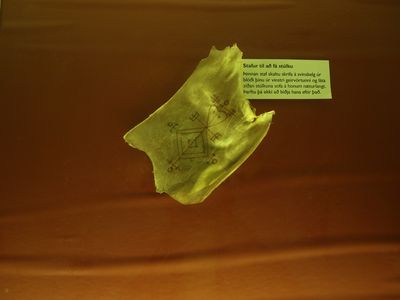
We got back on the road and shortly came across the Sheep
Museum, which was a bit dry in nature. It's a country house
type museum putting a lot of info together and trying to preserve
something before it is lost. They were surprised when we asked, but willing to sell us a copy of the English language information guide, which had a fair amount of information in it. These bottle-fed
lambs accosted us in the parking lot hoping to be fed. They were quite adorable.
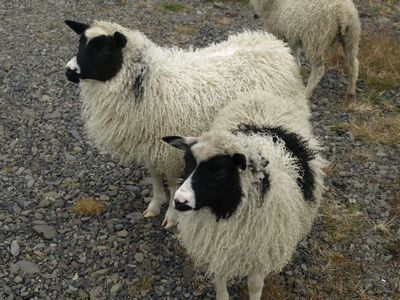
The trip continued into the North West ( link,
link)
of Iceland, with the Seal
Centre next. Karen and Neil differ on the value of this
stop - Neil feels that it provides a decent overview on the creatures
and a list of places to see them this year. He also thinks it's a good
cause to support - they do a lot of rescue and survey work. Karen
didn't take pictures at this one because frankly, the stuffed carcasses
and boring Victorian nature of the presentation just didn't appeal to
her.
We spent the night in the Hotel
Blönduós and loved the ocean-side view in
the room. Drifted to sleep with nothing but waves crashing on the
shoreline as background music. In the morning, we managed to get a few
shots of the bird-life and the shore-line.
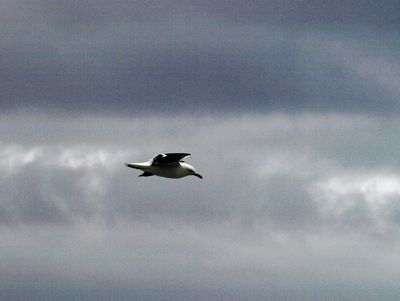
We had dinner in the "Pot and Pan" restaurant (probably newly named to
refer to the recent revolution here). It started with a wonderfully
spiced
lobster soup which was good, but huge. Karen feels she was full before
she even started on the main course. They also do Indian food and Neil
thinks the spices carried over. Neil ordered cod in tomato basil sauce
which was nice but the seafood gratin had too much salmon which Karen
doesn't enjoy as much so we traded. Both dishes were pretty good.
Thursday, July 30th - Blönduós to Mývatn
In the morning we hit the Icelandic Textile Museum (link,
link,
link).
It's an interesting museum if what you're interested in is a fairly
narrow historical review of textiles in Iceland that starts in the
1600s and offers no pre-history. There's a pile of material from no
earlier then the 1700s to the 1960s including a great collection
amassed by a teacher here in Iceland. Some nice tablet woven bands,
some interesting dyed wools, some 1800s fibre machines (early spinning
wheels, looms, and a large industrial spinning machine). There is nothing from
the Settlement Period and there is no English catalogue available. Some
neat "home life" stuff such as wooden buckets. They do allow pictures,
which is good. They supply cotton gloves so you can handle the
materials which is better. Finally, they keep the cases unlocked so you
can open the door to get better photos which is even better.
Karen was disappointed in that there were no references to pre-1600 era
textiles or textile tools but really that is the only complaint you can
raise with this friendly, well laid out museum.
This is apparently the very first sewing machine ever imported to
Iceland.
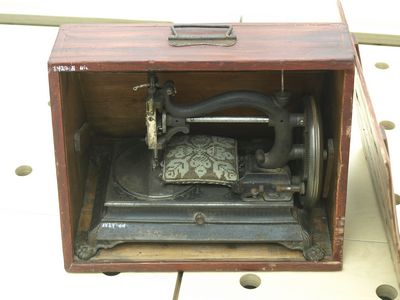
Our next stop was at Viðimyri,
a beautiful version of an old sod church. It dates back to
approximately 1834 and was fixed up and consecrated in 1935. Most of
the timber, and many of the artefacts inside are original but the turf
needs to be replaced regularly. This is a commonly pictured church but when you
see it in person it is much smaller than you think. It is also fun to
know that the church is still in service today.
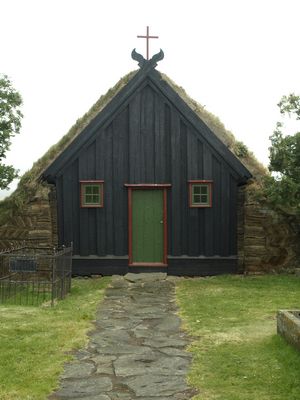
Glaumbær Folk Museum - The most interesting
part for us was meeting the archaeologists who are doing a dig on the
site. They
are from U.Mass. and UCLA, and were just coming up for a washroom break
when we arrived. The posterboard about the dig indicated that there is
evidence of pre-1104 iron smelting. In speaking with the archaeologists
we learned that they have found bog iron, and some "slag". The dig
began with a goal of validating some ground penetrating
radar techniques which seemed to work well. As a part of
verifying what the radar saw, they think they've found a
pre-1104 farmhouse. This is very interesting as Glaumbaer itself sits
on top of the 1104 volcanic layer and it was assumed to be settled
after the big volcano eruption. The new site just a few hundred feet
away is sitting cleanly below the 1104 layer and would represent an
earlier period of occupation. This is quite interesting and we hope
they get more funding
so they can explore further. Neil passed on his card to the
nice people. The archaeology thus far is currently unpublished as the
iron stuff is yet to be analyzed. It is of interest to the DARC iron smelting
experiments, so the more we can learn the better.
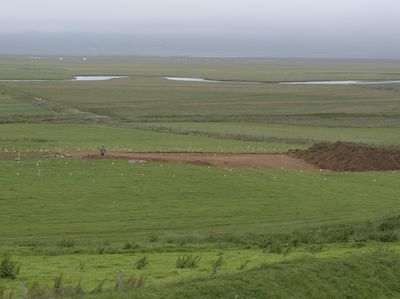
The museum itself has a restaurant/washroom building and a
reconstructed sod farmhouse which has multiple rooms
built off a single corridor. The various rooms are furnished in
different periods but mostly 1800s again. A very interesting point were
items like some buckets Neil
could point out in Viking Artefacts, yet these
were from the 1920s or later. It is surprising how little some things
changes. The museum itself is very well done as a museum providing a
broad range of time periods and artefacts and immersing you in the
smells and life, with good staff who are very enthusiastic about their
material.
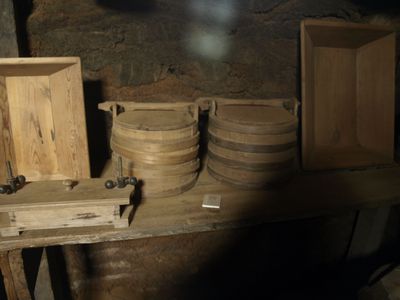
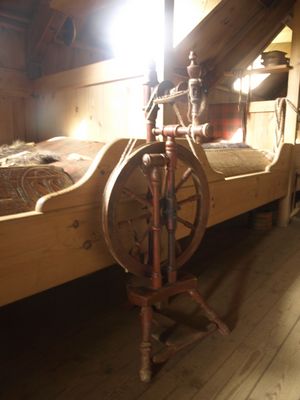
Karen got really grumpy photographing a
million things that she just doesn't find that interesting since they
are post-Settlement Age.
Being contrary then, here's the backside of the houses and the husband.
Karen always functions better in the outdoors here. Errr.... well
'always' might be too strong a word, but more on that later when we get
to Húsavík.
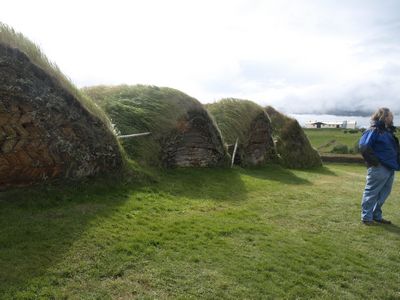
We made a brief pit stop in the rain in Akureyi in the North East (link,
link)
for two cables for Karen's Ipod. Karen is much much happier with music
around.
It was a long drive today, with lots of stops, and Karen was definitely
ready for arriving at the hotel, especially after getting grumpy at
Glambaer.
But we had yet one more stop to make.
Admittedly, it was the best stop we could have made to perk
her up. Fresh air, fast running water, and a complete lack of boring
1800s museums. Goðafoss (link,
link)
which loosely translates as "waterfall of the Gods" is so named because
when
Iceland officially converted to Christianity in 999 or 1000, the
lawspeaker of the Alþingi,
Þorgeirr Ljósvetningagoði was charged with
the task of throwing his statues of the Norse gods into the waterfall.
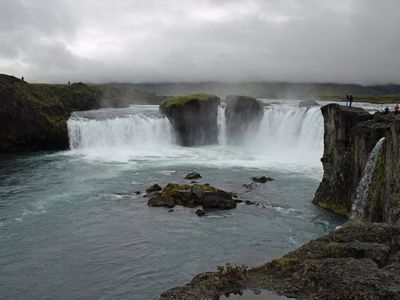
Snorri says "oh no, not me! I'm not a god!"
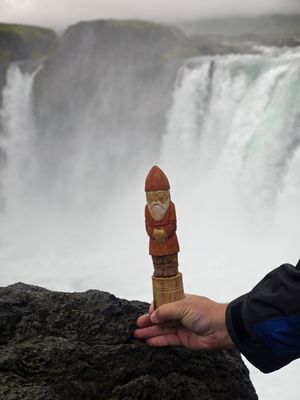
We have been taking some time playing with the camera to get the more
'artsy' shots, especially around waterfalls. This one turned out quite
well.
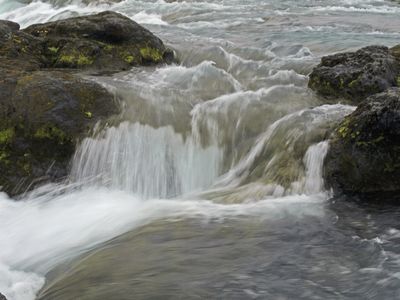
We finally ended that day in the Mývatn nature preserve, at
a lovely
hotel called Hotel
Reynihlið. We planned to stay here two nights,
because during the
day in between, we drove up to Húsavík to go
whale watching. The
hotel is a nice place with a decent restaurant.
We both had the langoustine soup - delicious, although Neil liked
yesterday's soup in Blönduós better. Karen had
reindeer on a stick (3 spears actually) with wild mushroom sauce
(mushroom sauce - yum), mixed vegetables and a citrus sorbet for
dessert. Neil had fried arctic char with an almond butter sauce (it
also had sliced almonds on top and the skin was left on both lovely
additions) and he had a raspberry zabaglione for dessert. Neil also
stole a bit of reindeer from Karen because it was new to him.
Friday, July 31st - Húsavík and
Mývatn
Breakfast at the Hotel Reynihlið is worth mentioning
because it was different then the standard Icelandic buffet breakfast.
More then halfway around the country and it had yet to vary from a
collection of smoked fish, pickled fish, cucumbers, tomato slices, hard
boiled egg
slices, thin slices of mild cheese, two kinds of cereal, several kinds
of milk, two
kinds of bread - both of the harder variety, jam, coffee, juice, tea.
At the Hotel Reynihlið, they added scrambled eggs and bacon,
kiwi, fruit
salad, french toast and more.
The plan for today was a trip up to Húsavík
for some whale watching. The drive up was short and easy and
since we had some time before the whale watching tour started we
went to
the
Phallological Museum.
Yes, that's right, it's a museum dedicated to penises. Most of them are
like these in the picture, preserved in formaldehyde. But there are a
few dried and mounted, and a few that have been made into other objects
like a penis bone walking stick, bull penis bone officer's swagger
stick, bull penis skin whip. There are even three letters, from three
different currently living men, who promise their penises to the museum
upon their demise. One of whom is the current curator of the museum,
two of which provided rubber casts of the members in question.
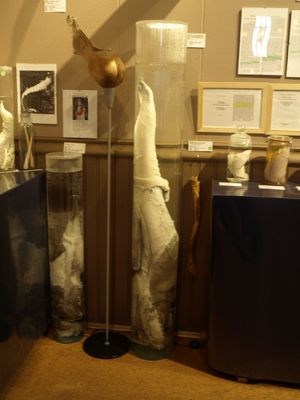
So, whale
watching then. Cue.... the theme to Gilligan's Island. "A
three hour tour... the weather started getting rough... the tiny
ship was tossed.."
First bad sign - they canceled all runs by the smaller boats and only
used their big one. Next bad sign - they gave out drugs to anyone
buying a ticket. We probably should have taken the hints.
Here is Karen starting out all cheery like in a tower of the orange waterproof jackets they provide. Note the calm water of the harbour behind her.
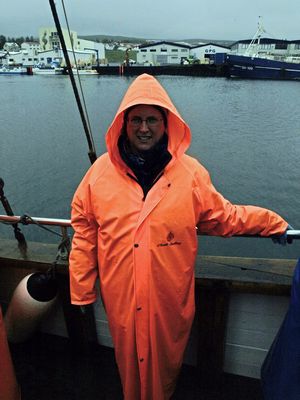
Three hours of not finding whales while fully half of the
people on the boat are occupying the rails tossing their cookies or
wishing they had any cookies left to toss. Fun - Wow! There were whales
around - the lookouts spotted them diving a couple of times but they
never surfaced near us.
And here is Karen, after the first or second tossing of the cookies.
She spent pretty much the entire
3 hours vomiting. It was.... just so very much fun. And she notes quite
querously that she really did take the darned sea-sickness pill they
gave us, just in case. It just didn't work. Mind you this was
her first time being sea-sick and clearly she nailed it! Neil managed to hold unto his lunch, but he notes it was a close call even for him.
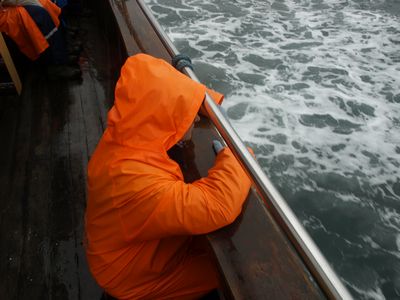
They offered free vouchers for another trip, but there is no way you'd
get Karen back on that trip for quite a long time so we declined.
Neil did get a couple of OK pictures including some of a cormorant that
overflew us. Apparently it's quite unusual in this part of Iceland.
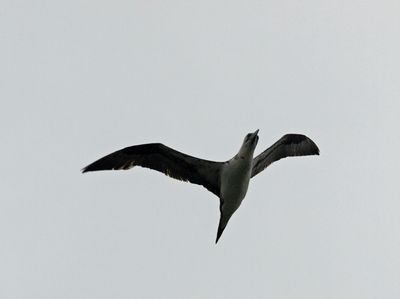
Karen didn't feel like hitting the whale museum or the local
folk museum or even dinner that night, but we did get to the Mývatn
Nature Springs. Mývatn Nature Springs is very like the famed Blue Lagoon in southern Iceland, but not as crowded, a bit warmer, and about half the price. A long hot soak in one of Iceland's hot
springs can cure many ills.
Snorri thinks it's much nicer then that waterfall we threatened him
with as well.
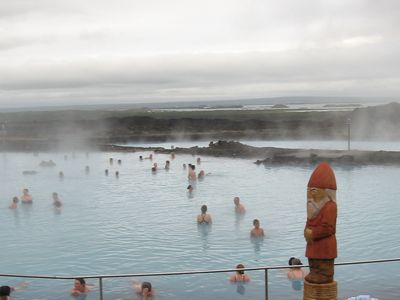
Saturday, August 1st - Egilstaðir
Waking up in Mývatn the next day, Karen was much refreshed
from the
travails of the day before and it was a bright sunny day with winds
from
the southeast. A great day to drive to
Egilstaðir. Just over the hill and around the corner
from Mývatn, we stumbled on
this site that we hadn't been expecting - Namafjall Hverir
- another
heavily loaded geothermal site, much like the one near Gullfoss in the
south.
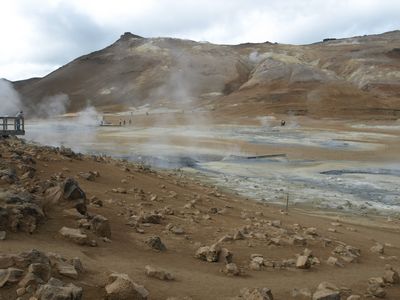
The
Namafjall region is close to Krafla, one of Iceland's still active
volcanoes. Karen started piecing together how geysers work, and their
relationship to volcanoes. Go, shoo.... look it up on Wikipedia
yourself. Karen
did
when we finally paused in the hotel at night. Did you know that
Yellowstone National Park is basically just one huge supervolcano? That
even just one explosion of a supervolcano could completely change our
entire world literally overnight? Let's not dwell on it.
This is just one of the prettier pools of bubbling hot water,
superheated by underground magma pockets.
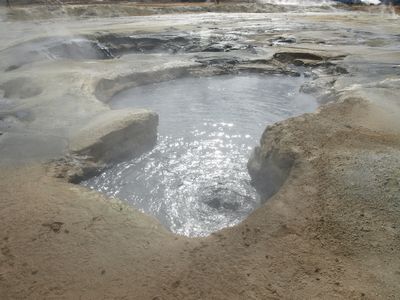
This is a steam vent. Karen likes this picture. She looks so....
tentative.
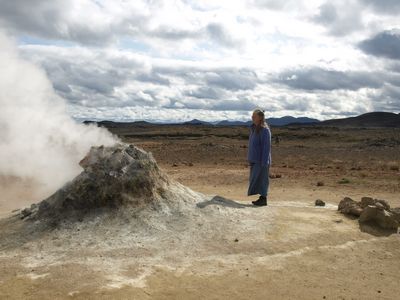
Snorri just sighs at being threatened with hot steam once again.
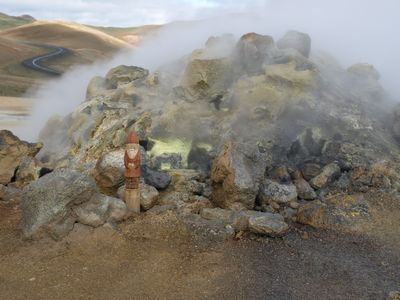
Then another planned stop - it's yet another waterfall. We don't really
feel like
that 'yet another' thing, because we really enjoy them, but we do
wonder if our readers are going 'what, another waterfall?' as
they follow along. Iceland has literally hundreds of them, all around
the country.
This is Dettifoss
(another
link).
It is the largest waterfall
in Europe in terms of volume discharge, and it is largely glacial
runoff from Vatnajökull. A nice place with a semi-fun
drive in - Neil might have called it a real fun drive except
that we had been to the West Fjörds first and he knows
what truly amusing driving can be. Everything here is also pretty geologically young
so the
walls of the canyon are rapidly eroding. The water itself is very dirty
from the run
off of the glacier and the grit contained in the water is incredibly
fine. What strikes you most though is the sheer speed and power of the water pounding through this waterfall. Faster! Stronger! then most that we've seen. This is NOT just another waterfall.
For some comparison, Dettifoss is 44 m high, while
Horseshoe
Falls in Niagara, Ontario are 53 m. Dettifoss is 100 m wide compared with 671 m
for Niagara falls. 2520 cubic
metres per second of water
go over the Horseshoe Falls at high flow. Dettifoss
has 600 cubic metres at high flow. Dettifoss has
20% of the water of Horseshoe Falls flowing through only 15% of the
space - the water is
much faster moving!
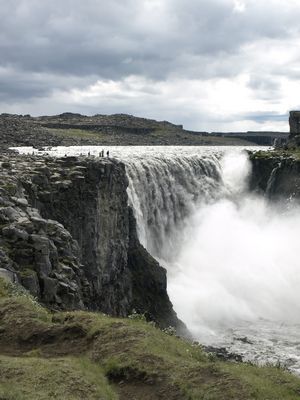
Neil
pauses in the sunshine to enjoy the water flowing past him. Unlike at
Horsehoe Falls, we can walk right up to the edge of the glacial runoff
river feeding the falls, and dip our hands in. It's freaking cold!
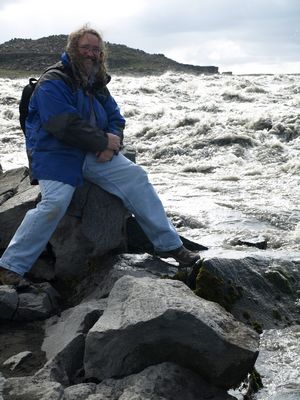
Back
on the road again and headed into the East (also),
Karen has been making it her ambition to get some of the
thousands of sheep that she's seen on film (ed - electrons dear, film
is
so old school).


We
spent the night in Egilstaðir at the Hotel
Herad - another perfectly serviceable North American class hotel with a
restaurant. Lobster tails and garlic bread to start, then a
reindeer steak in a blueberry/red wine sauce/gravy with blueberries,
roasted vegetables, and amusing potato pie slice with fresh
strawberries, and an apple/blueberry/skyr compote on the side. Then
skyr
and fruit and cream for dessert. Yummy. Karen had the monkfish on
risotto and creme caramel for dessert. Also quite delicious.
Sunday, August 2nd - Höfn
Egilstaðir to Höfn in the South is a long drive
- 250 odd km, so we decided to skip the two waterfalls (Litlanesfoss
and Hengifoss)
that would have been an 80 km detour into the rain, and just let the
road itself
entertain us along the way. There aren't really that many planned
tourist distractions on the east coast. I know to North Americans
hearing us say 250 km is a long way sounds very silly. Here at home we
have friends we see regularly that live that far away. But in Iceland
distances are deceptive, and there is always a distraction waiting to
take you off the road for a while.
Karen looked for salt and vinegar potato chips before getting on the road again and is really becoming quite despondant with her lack of luck. How can an entire country abandon sane snacking?
It turns out that there are really three ways to get from
Egilstaðir to Höfn. If you use this map and zoom in on the route you can see that route 92 to
Reyðarfjorðr is the longest, with route 1 to
Breiðalsvik being a good chunk shorter. But part way down route
1 there is a blue question mark. On a real map that is the location of
route 939, a tertiary road off route 1 to Berufjorðr. Given
that it
was raining pretty hard we decided to take route 1 as directly as we
could. Route 1 got pretty rough in some spots and then we saw route 939.
Figuring it couldn't be much worse than route 1 was at that point and
since
it was only 21 km long we figured "why not? let's see if it cuts time
off and
gets us into Höfn faster so we could soak in the hot pots and
commiserate about the rain." Turns out route 939 is in much better
shape than route
1. We climbed up into the mountains and deep into the clouds within a
few kilometres. The road was straight forward but 'things' loomed up
out of the fog and the mind started playing tricks. Let's just say it
was important to watch the yellow wands of the road because it was the
sort of day you could take a wrong turn and wind up in Alfheim before
you knew you'd even left the road.
After 10 km we hit the high point of the mountain pass and started down
again - soon enough we dropped out of the clouds and then Thor gave us
a
present. On the side of the road was a pull off and a VERY cool
waterfall, and then the rain
promptly stopped very briefly.
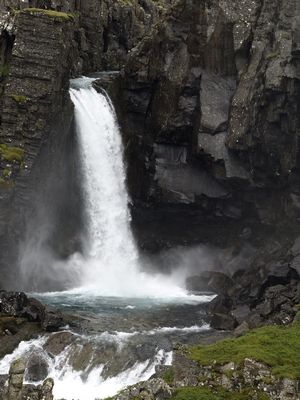
We got out, stretched our legs enjoyed the stunning view down
into the mountain valleys and of this lovely waterfall. When we
had enough, we got back into the car, the rain started again, and down
the hill we went. It's kinda twisty.
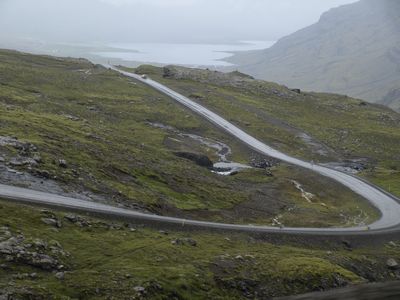
Back on the main road headed to Höfn, we noticed
that it was around lunch so we pulled off the road at one of the picnic spots
they seem to put every 5 or 10 km here. It was still raining so we ate in the
car, read books for a bit, then the rain slacked off and stopped, so we
decided to stretch our legs, and bingo - another incredible waterfall!
If the day had been sunny and remotely warm, we could have gone
swimming
in the little pool at the base. We took pictures instead, and then back
to the car as the rain started again.
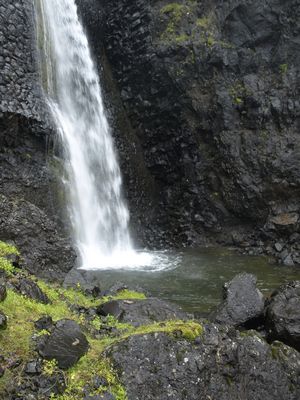
A little way away from Höfn, we noticed the sky
was getting brighter and the rain was slowing down. This is just the
coast
line, as we are starting to approach Höfn. It's still overcast
and rainy, but the coast is getting craggier. It's so pretty that Karen
defied the rain to get a shot.
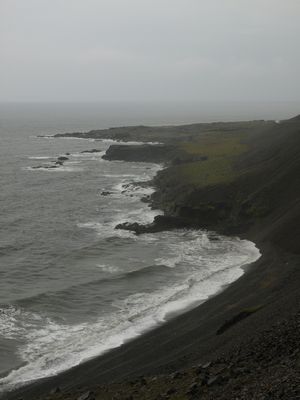
The road went into a 1.3 km tunnel through a mountain, out
the other side and presto - broken clouds and blue skies and our first
view of Vatnajökull.
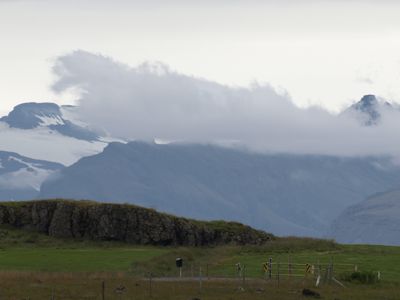
A few kilometres later we arrived in Höfn. We decided
to walk around town and explore a bit. Unfortunately it was late
afternoon on a Sunday so not a lot was open but we did find
another cat.
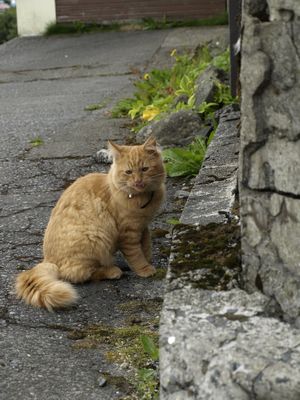
We went to the Glacier
Exhibition, which
was just chock full of science and yet very well presented. It's a mix of
boards full of facts, frequently asked questions, a short film, a solid
scientific presentation on glaciers and expeditions to Iceland's glaciers,
films shot on Iceland's glaciers (two Bond films), and cool things that
have happened at Icelandic glaciers. One example was
a massive outflow in the course of just one day involving 45,000 to50,000 cubic
metres per second of water- 20 times the flow over Niagara
Falls. You can even go up on the roof and look at the outflow glaciers
in
the distance (all nicely labelled). A very nice little exhibition!
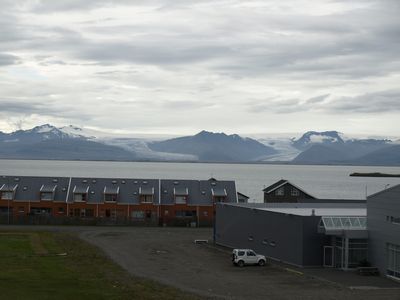
In the exhibit, while Karen was still capable of absorbing the
science, she couldn't help but think that our friend Marcus is just
going
to go totally crazy here. This entire country is a geologist's wet
dream.
You could spend a lifetime investigating the geology of Iceland and
still not get to all of it.
We stayed at the Hotel
Höfn -
it's an interesting place with both a main building and an expansion across the
road that seems to have been two 8-unit buildings which were
redone as 20 hotel rooms each. We went over to the hotel for dinner -
there is much goodness to be had in a lobster town. First though
we should really clarify that "lobster" means a "Norway Lobster"
or "langoustine". After all a "lobster tail" here is 3 or 4 inches long
not the 6-8 inches that Canadians would probably expect. With that out of
the way, we had a nicely spiced creamy lobster soup to start, then "Lobster
Höfn meets Asia" - nine lobster tails split and spiced served
with garlic butter drizzled over them, two lobster stuffed spring rolls
with spicy sauce and some salad. For dessert, we both had "Skyr three ways" - skyr
with cranberry gel flavoured with cinnamon, mandarin skyrmousse with
blueberries, home made coconut and skyr ice cream. Karen has a
different
opinion on that cranberry gel flavoured with cinnamon concoction - Neil
loved it, she thinks it tasted like cough syrup.
This is the
Vatnajökull glacier at 11:30 pm (ish) from the beach near our
hotel at Höfn. So peaceful.
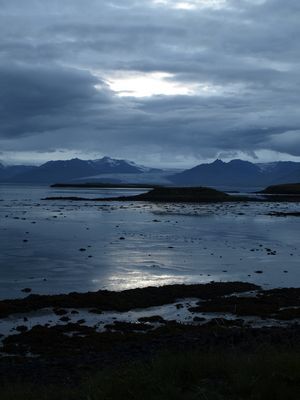
Monday, August 3rd - Jökulsárlón
This is Vatnajökull in the bright sunlight as we
neared Jökulsárlón.
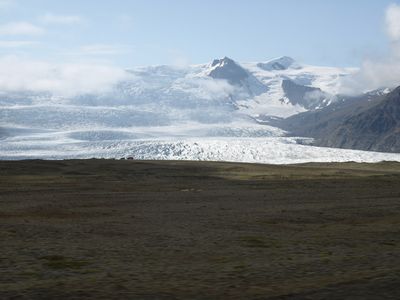
Jökulsárlón
(official website) is
a
lagoon created by the melting of the largest glacier in
Iceland, Vatnajökull. It's filled with icebergs that have
broken off from the glacier and are in the process of melting as they
mix
with the warm currents of sea water.
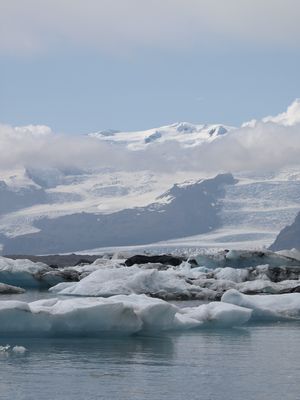
These intriguing boats will take you out into the lagoon for a brief
runabout, where a guide carefully explains the nature of glaciers and
the formation of the lagoon, including the timelines involved. It
is thought that the glaciers in Iceland were much much smaller in
the Settlement period (ie, Viking Age) and that the settlers farmed
areas that are now buried in glaciers. Imagine doing that kind of archaeology!
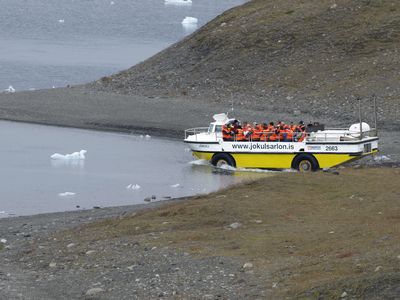
Glaciers are dirty at their leading edge, picking up the earth as it
moves. When an iceberg turns over, having left all that dirt at the
bottom of the lagoon, it is a beautiful crystal clear ice that slowly
turns white as the sun crystallizes the surface. This is a freshly
turned iceberg.
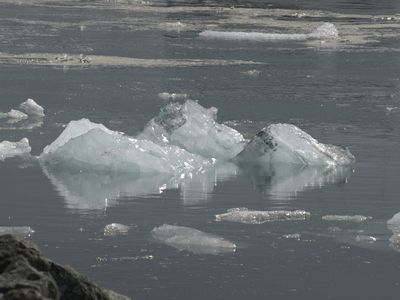
This one, Neil and Karen are debating. Does it look it a duck or
a seal to you?
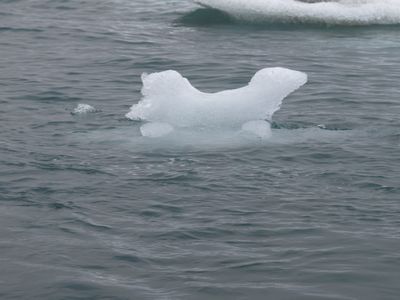
And speaking of ducks there is an abundance of wildlife living in
or around the lagoon. And Karen is a sucker for cute wildlife.She
caught this
cute baby duck in mid-shake.
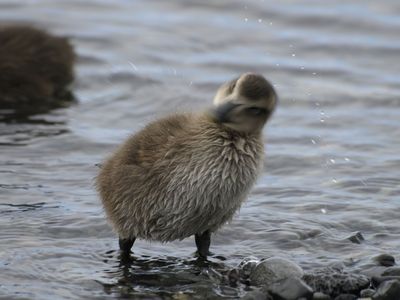
And while we were hunting for seals in the lagoon, we caught this
little
bird of some sort in the rocks in front of us.
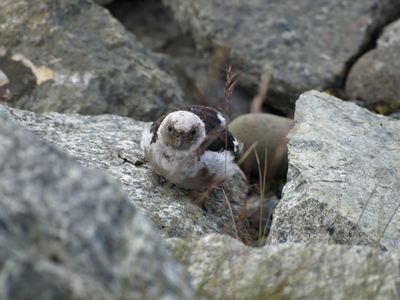
Found a seal! As the salt water of the sea mixes with the fresh water
of
the lagoon creating interesting patterns of currents, seals often chase
fish into the lagoon.
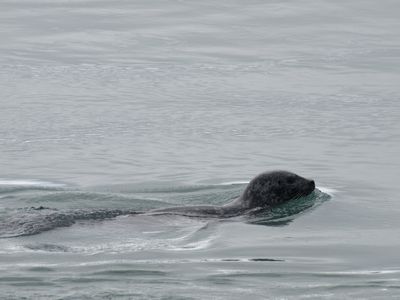
Neil caught this arctic tern on an iceberg with his meal in his beak.
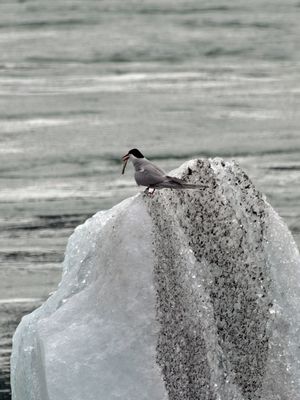
Snorri had an overview of the icebergs "Why is it always water
with these people?"
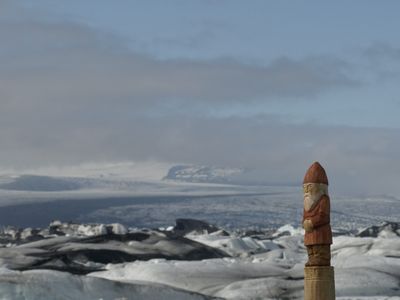
"This is so undignified."
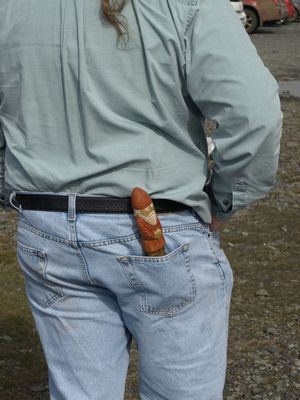
We spent several hours at Jökulsárlón. The half hour boat tour of the lake was
fun, loads of icebergs, and they take the time to try and teach you
about this glacier at every turn. For those who don't
know, Vatnajökull is the largest glacier outside the polar
regions. It has a huge number of outflow glaciers and
Jökulsárlón is a lake formed by the
outflow of one arm back in the 1930s when the glacier began a big
retreat. The lagoon has kept growing as the glacier pulls back and now
it is huge and full of icebergs. We learned about the colour
codes of
icebergs and got to eat a piece of one. We were fascinated!
We spent the night at Fosshotel
Skaftafell which is a pretty plain hotel, with lots of out
buildings. No internet in the room
but it works in the bar. Dinner was rustic but good solid food.
Fish "stew" for Neil, which was thick enough to not need a bowl and
covered with hollandaise sauce and cheese. Karen can't remember now what she had. Then we both had skyr for dessert.
Tuesday, August 4th - More Glaciers and the road to Ranga
After visiting
Jökulsárlón, Karen was intrigued by the
glacier that we could see from the hotel window which is called
Svinejökull. It looked so close and Karen wanted to
get right
up to it. Distances are
deceptive in Iceland, and it wasn't really "just outside" the hotel
room, but several hills away. So we took an access road for glacier
climbers and walked in instead. Not being in safety gear, we
didn't attempt to climb on the glacier itself but we did get very close
to the leading edge. It was very dirty but still very
interesting.
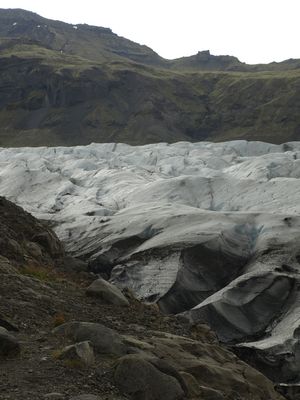
On the road we found this sign for Darrell, who is usually
called Ketill
in DARC. For those not familiar with Icelandic,
Ketilsstaðir roughly translates as Ketil's farmstead. Taking this picture was an amusing process, given that the rain was quite heavy, and opening the window just long enough to get the picture nearly drowned the whole interior of the car.
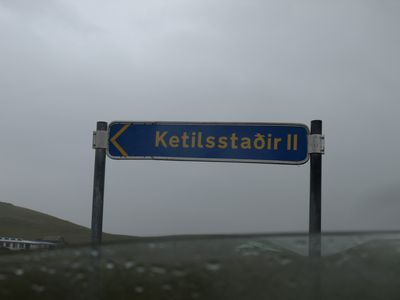
Our next stop was at Kirkjugólf, just
outside of the village of Kirkjubæjarklaustur.
Kirkjugólf (Churchfloor) is a natural pavement of basalt. These are basalt columns in the earth, but only the tops can be seen, and as the name suggests, have the appearance of a paved church floor.
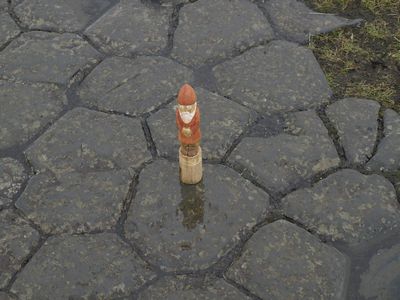
Neil got his waterfalls mixed up. Karen really wanted to see the
one that you can walk behind and he thought it was this one, was utterly
convinced that it was this one. So he said "let's go", and starts
plunging
toward the waterfall. The mist layer is so heavy it's starting to soak
us and Karen is yelling "no way, can't be this one" and finally he
figures it out too and stops. Neil thinks Karen tells a way better
story than the simple truth of walking along the shore towards a
waterfall undeterred by the spray until you can get close enough to
see around the rocks that there is no path behind the fall itself. Karen thinks that if he'd actually looked instead of determinedly hiding his face from the spray and plunging ahead, he could have seen that there was no path a whole lot sooner.
By the by, the name of this waterfall is Skogafoss.
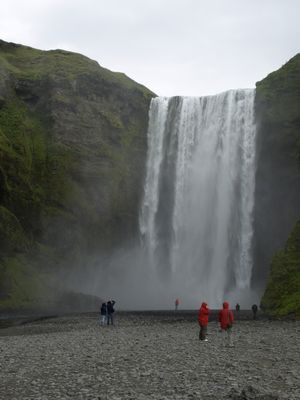
Skogafoss is right next door to the Skogar
Museum
- yet another "folk" museum. Very 1800s as a museum, room after room just
jam packed with "stuff". Some of it labelled in Icelandic in single
sentences (with a little Icelandic flag to let you know it is in
Icelandic). Sometimes there is some english text. Mostly the contents
are 1800s or later (one
room has some WWII military stuff, and old tvs for example) but some of it
goes back to the Viking Era. It is amazing how
much some things didn't change here - for example buckets that were
dated to
1820 or 1870s that Neil could point out in a Viking artefact
book.
One
case of Viking Era stuff included some iron production slag and what
looked like 2 blooms. Truly this is the sort of place that will drive
you
nuts because it is hard to find something specific or learn much about
it if you do find it - but you could spend DAYS looking at all of the
cool stuff. (Or maybe just an hour if you're humouring your husband
even
though you're not into overcrowded museums full of junk from centuries
that just don't do it for you.)
Then there were the buildings. Turf and stone houses, wood
houses, a church, a school. All carefully moved here and fixed up (and
dated) including the first wooden house from the district (1878 by the
way). Nice to be able to see them. Overall it was really well done for
its type of museum. Even Karen found interesting items
like this thing, apparently 17th century, which is the
remains of a header for the warp-weighted loom, which was in use in
Iceland well into the 18th century.
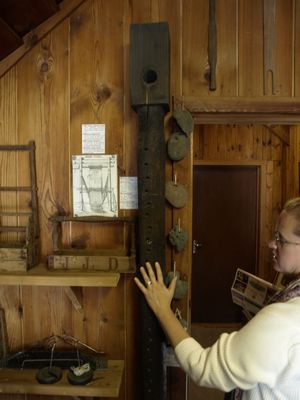
Now this is the waterfall - Seljalandsfoss-
that you can walk behind. It's really really cool, and
somewhat terrifying inside the cavern because the sound of the water
falling echoes and vibrates and you think you're in the middle of an
airplane taking off but it's all around you. That's the sound of literally tons of water both falling in front of you and echoing around the cavern, and of the huge river above the roof of the cavern that is about to become the falling water.
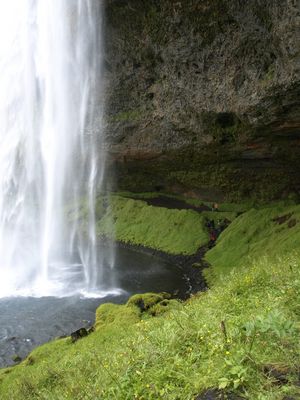
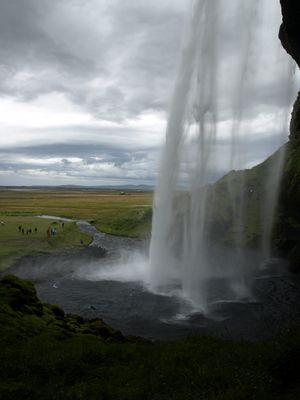
We then continued onwards to the Saga Centre
in Hvolsvolur, our last stop before the hotel this day. It is focused
on
telling the story of Njala's saga. It's really well done in one way - lots of large boards with pretty pictures to tell the tale. But
oh my - where do we even begin on the 3 dimensional stuff they are
using to flesh out the story?
The blade on the spear is wrong, the shield is the wrong shape, the
helm
is wrong, the broaches are wrong and the shape of the cloak is wrong!
That's just one of maybe a dozen such characters, all filled with
looming inaccuracies.
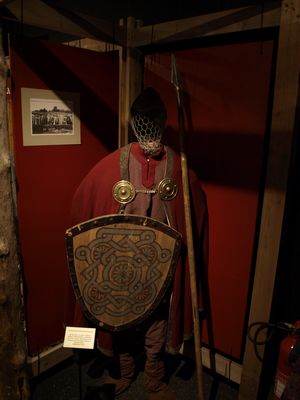
And then that day was over.... it was a long long drive to what
is billed as Iceland's only 4 star hotel and restaurant. Karen might
agree that the restaurant deserves 4 stars, but sadly, not the hotel.
In fact, she thinks it's earned the dishonour of the hardest beds in
the entire country. And the outdoor hot tubs weren't at all hot.
*sigh* The Hotel
Ranga does have the hardest working staff Karen had met yet
for trying to please,
and Icelanders seem to try hard to please as a general rule. Dinner was
Humarsupa (lobster soup)
to start. It had a little thinner broth than we prefer but so
many
wonderful flavours in it. Spicy but in the best way with lots of subtle
flavours. Then monkfish stuffed with a herb/lobster paste, on pureed
potatoes in lobster gravy with veggies. Karen had the same dishes. For
desert Neil had skyr mouse in a hard chocolate shell with rhubarb in a
rhubarb sauce. Karen had fresh Icelandic strawberries with estragon and
champagne sorbet.
Wednesday, August 5th - Ranga to Hengill
The next morning we were off to the Hekla
Volcano
Centre, in the shadow of Mount Hekla itself. A wonderful
presentation if a little light on the facts. The
centre uses several modern techniques like a tilted floor
and ambient noise to disorient and disquiet its patrons, to emphasize
thedestructive power of volcanoes, and Hekla's history in particular.
A very large eruption in 1389 earned it the nickname of
the Gateway to Hell because its ash clouds made it as far as
Scotland
and England, and destroyed farmland for miles and miles around.
These ash layers are part of Iceland's archaeological dating
method because eruptions were recorded in some fashion as far
back as 1104. This photo, taken in the National Museum of Iceland shows the ash layers. The explosion in 1389 is that big band of dark colour just below the middle. The 1104 eruption is dark layer near the bottom.
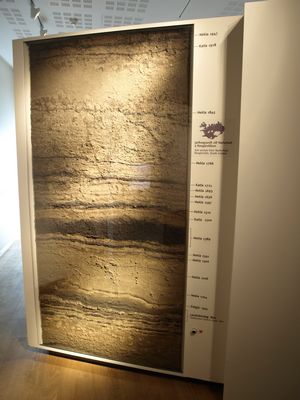
This is Hekla today - note that people are moving back into the
area. Karen isn't sure she'd be comfortable living so close to an
active volcano that tends to erupt every decade or so. The last eruption was recorded in February/March 2000, and experts are expecting another one shortly.
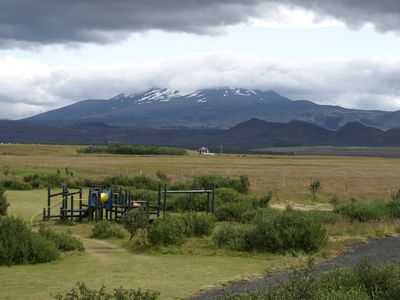
Hekla is calm today. Well, on the day Karen took this picture of
the seismometer, anyway. It's very reassuring.
The Volcano Centre had one fantastic cafeteria. Great food, and a waiter who studied hospitality in the US. He had us laughing about pronounciation of the language, telling us a nonsense poem about rolling one's r's in Icelandic. He went out of his way to find some malt vinegar in the kitchen for Karen's fries - the first time she had vinegar in any form in the entire country.

Our next stop was Stong.
which is
a recreated Settlement Period (ie. Viking Age) longhouse. The original
(just down the road) was buried by ash during Hekla's eruption in 1104.
Archaeologists uncovered the site and a recreation was built
in 1974 as part
of the celebration of the 1100 years of Iceland's settlement.
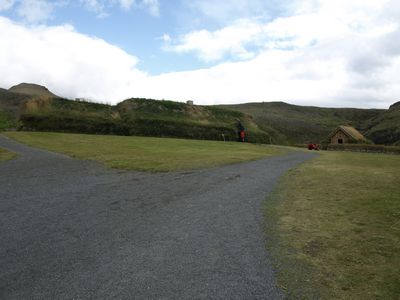
It was very well built, but Neil and Karen both agree that it
really needs re-enactors to bring it to life.
Snorri approves.
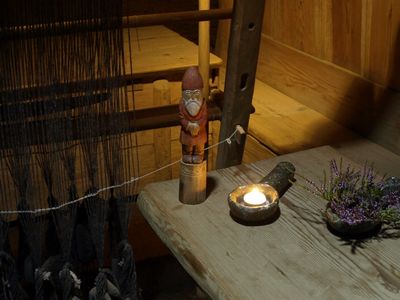
This warp weighted loom is on temporary loan to the Stong site. It
is beautifully set up, and has obviously had a very competent
weaver behind it at some point.
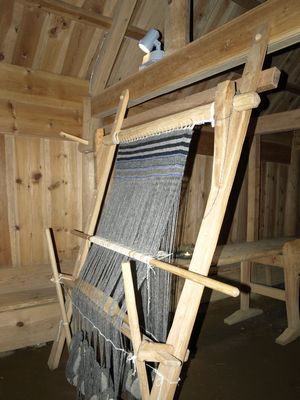
We then stopped at Thingborg in
Selfoss which is a wool co-operative. Karen had fun here - lots and
lots of
yarn that isn't the boring lopi that Alafoss markets ad nauseum to the
world. Imagine Icelandic fleece heathered and plyed, and handspun
properly. When we were exploring the web in preparation for the trip,
their webpage had a picture of a warp weighted loom, and Karen got
quite
excited by the idea of seeing it. She wanted to talk to the weavers in question and
see
what they know about weaving on this type of loom.When we got to
Thingborg and couldn't find it, we were puzzled and inquired.
Apparently
the loom on the webpage is the same loom that we'd seen that morning in
Stong! We passed on our compliments on the weaving.
We spent the night at Hotel
Hengill, a part of the Icelandair hotel chain, which was
a pretty normal hotel. We
chose Hotel Hengill after the Hotel Valholl in Þingvellir burned to
the
ground a few weeks before our trip. We had wanted to be near the park
so
that we could go wandering in the park after supper, after the crowds
of
tourist buses had left. The weather had a different idea for our
evening
however. It rained all evening too hard even for the hotel
outdoor hotpot, never mind a walk around the national park.
Thursday, August 6th - Þingvellir to Reykjavík
We started off Thursday morning by getting up and deciding to go
to Þingvellir, rain or shine. Unfortunately it was raining,
but when we got there the rain mostly stopped, at least for a
bit. We went to Oxarfoss first to
try out some photos with the tripod. Longer exposures can be
done better with a tripod, humans find it difficult to hold a camera
steady long enough and since we did bring the tripod to Iceland we figured that we
might
as well try using it.
The longer exposure provided really cool water but strange colours in
the rock and moss. Clearly we need to return to fine tune this idea a
bit.
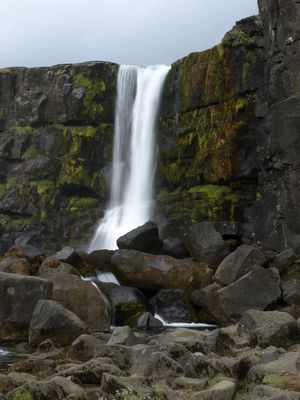
The rain started again in torrents as we were midway up the continental
divide. Neil went back for the car like a gallant gentleman, and Karen
trudged
up to the tourist centre at the top, which was somewhat closer. Karen
pulled
off layers and tried to dry out while watching films of the lake and
other UNESCO
world heritage sites while waiting for Neil, or the rain to stop,
whatever would come first. Unfortunately the space had to be
shared with dozens and dozens of other tourists all hiding in
the
only shelter short of their cars or buses.
Snorri is seen here overlooking the valley and the nation's guest
houses
for visiting dignitaries. Another picture taken in haste in the rain. The hotel that we would have been staying at
was right across the river from the dignitaries' guesthouses but
it burned to the ground a few weeks ago and now it's a lawn.
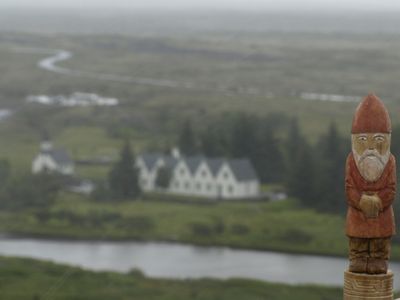
We headed back to Reykjavík with a brief stop at the factory outlet store for Alafoss,
Iceland's leading wool producer / exporter. The dollar exchange in the
last year has effectively made this wool about half the price we can
get
it for in Canada, but Karen was a little afraid of how little room we
had
left in the suitcases so she didn't end up buying anything. Besides,
Thingborg had spoiled her for better ways to treat this unique fleece.
We visited a knifemaker just across the street from Alafoss as well - nice handles and
sheathes but simple
knives - we've been spoiled by the work from the Wareham Forge.
We arrived in Reykjavík in the early afternoon and went to
the student
bookstore at the University of Iceland to hunt down a book for a friend but
we couldn't find it. It is a nice big bookstore though with
lots of stuff in
english and some very helpful people. Last year we had picked up a
children's version of Njala's saga in English. There were no
new sagas released in English but we picked up some of the other sagas
in the series in Icelandic. Kid's books are a great way to learn
the language.
We also went to the National
Museum which is sort of next door to hunt in their giftshop, since they did
publish the book we were hunting for in the first place.
Unfortunately they managed to determine that it was sold out, all
across
Iceland and at the publishing house.
We were going to leave, but on a whim, Karen asked at admissions if they
had changed their
policy on taking pictures in the museum. Last year, we were told no
pictures were allowed, which was our major complaint with this museum. This
year the policy had changed and pictures were allowed! Neil
went back to the car to get the camera! The lighting level is
quite low in the museum however and
pictures were extremely difficult to take well. These few are the best
of
a bad lot. All are approximately in the Settlement Period. Most of
the pictures are Neil's - Karen was feeling sufficiently under the weather that she couldn't hand hold the longer exposures without
shaking. Early symptoms of an oncoming cold - perhaps too much time in cold rain?
Beads from the Settlement Era.
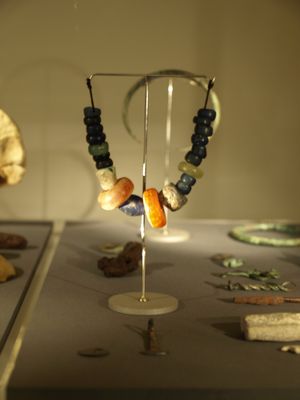
A textile bit - probably tablet woven trim.
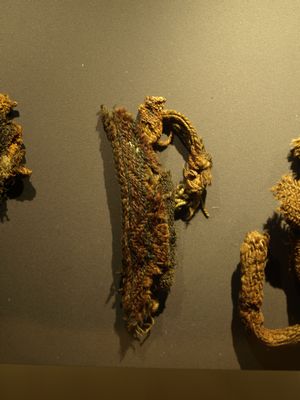
The picture below is a reconstruction of the current thought of what a
warp-weighted loom would have looked like based on later period
evidence. It should be noted that there are very few actual remains of
these looms from the Settlement Period. There are no actual whole
looms.
Loom weights, sword beaters, a pin beater, spindle whorls.... but no
actual loom frames.
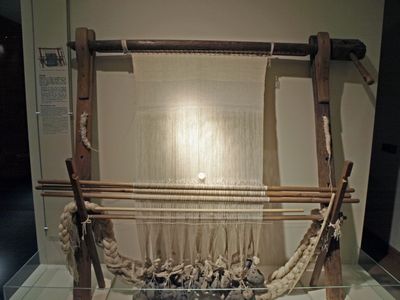
An axehead.
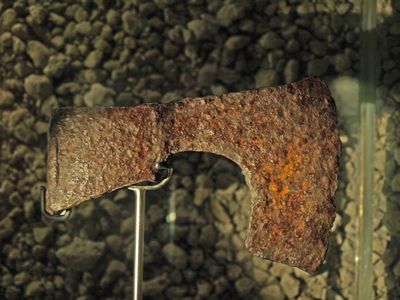
That night, we went out to dinner with Michele,
an archaeologist friend from Rhode Island, who had just arrived in Iceland
to study the nation's textiles. Karen was distressed to learn that Michele had forgotten to bring salt and vinegar potato chips with her (requested via Skype), but quickly forgave her because she's such delightful company. We returned to the Tapas Barinn for
another night of wonderful tastes and sangria! Elín, with whom Neil had
been corresponding about bead finds in Iceland, joined us later for
drinks. Much conversation and a late night later we returned to the
guesthouse.
Friday, August 7th
We woke up Friday morning to head off to the National Museum archives
with Michele - Karen to look at textiles as her assistant and Neil to
look
at beads. We are not allowed to publish those pictures. While we're
quite sure they mean for profit, we're going to err on the side of
caution and apply that rule here as well.
Except for this one of Snorri of course, seen here sitting beside the
boxes of textile remains that Michele and Karen got through after 7
hours of
eye-bleeding staring at small fragments, tiny weave patterns, the set
of
the spin - all in various shades of unrelenting brown. Michele started calling them 'dirty brown rags'.
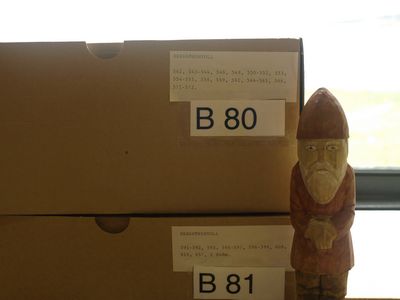
It was exhilarating! Karen got to touch (with gloves of
course) fabric pieces that were quite possibly a 1000 years old! Neil got to look at (and touch, with gloves) beads in the same sort of age grouping. Even more important, he got to take all sorts of measurements from them. He found it exciting to be able to see evidence of some of the same sort of errors that we are making in our experimental reconstructions. We
took
pictures of things that probably will never get released to public
viewing because the museum has boxes and boxes and boxes and still more
boxes of these things. Yes, we know we're weird. :) But it's a good
weird.
We went to the hot pots afterwards to rest our weary eyes.
And then out to dinner, again with Michele, this time to a place called Orange. It was an
accidental find, in that we had aimed at another place nearby and were
turned off by the crowds and dingy appearance of the place. Orange is
pretentious, terribly trendy in design, has at least the
one waitress who couldn't bring herself to smile or even be polite, and
it was still a fantastic experience! The food was divine and experimental,
and there's weird science with
liquid nitrogen both for the cooking thereof and for entertainment.
I'll
say no more. Go and look them up on the website, and if you get to
Iceland - go with friends who love food and laughter.
Saturday, August 8th
This was our last full day in Iceland and we slept in deliciously
(a rare
thing for Karen in Iceland), and then picked up Michele to go shopping
and to amuse
ourselves with the Gay Pride parade through downtown
Reykjavík.
It was a party for sure, but way more tame then Toronto's Gay Pride
celebrations - sorry folks. I know Reykjavík likes to think
it can party, but it just doesn't have the sheer volume that Toronto's
crowd can offer. Although admittedly, the party mix of loud disco-gay music is much more pleasant in
Icelandic then in English.
Oh, and there was the flea market (Kolaportið),
and
more shopping, and a bite of hakarl - fermented shark. Karen had made it
her
goal to give it a try this year. She said she would not leave
the country without
doing so. Neil and Michele stood breathlessly by, watching Karen's face after priming her with stories of their first time trying it. It is a memorable experience and we will say no more, least we spoil the
surprise.
Neil and Karen were trying to find souvenirs to bring home for family, and having rotten luck at it. Michele was trying to avoid large amounts of spending, being that she was there on a grant, but some fancy footwear broke her resolve.
For our final
dinner, we ate at the Geysir
Bistro
and Bar - good food right in the downtown. Karen had arctic
char and Neil had a great seafood quesadia. The evening was a little
melencholy with the knowledge that we would soon leave. Karen would miss
the fresh air, the wild wild geology of this place, her first
(hopefully not last) encounter with the National Museum
archives, and all the seafood along the way.
Sunday, August 9th - Heading Home
We headed off to the airport via the Blue Lagoon with Michele along for the soaking part of the trip. She was staying in Iceland for a few weeks yet but couldn't resist the chance to socially soak in the warm waters. Hot pots are social events in Iceland.

We finally left the Blue Lagoon, waving goodbye to our friend, and made a quick pitstop to fill up the gas before returning the car and making a last minute purchase of as much skyr as we could fit into the luggage. We spent a few precious minutes crazily repacking to fit the skyr into what would be the checked luggage - it's liquid enough that we couldn't carry it in carry-ons for security reasons.
We got to the airport with what should have been an hour to spare - if Neil hadn't mistaken the time of the flight. We just barely made it onto the plane in time. Ah well, no time to linger moodily for missing the country.
We had decided to go home via Boston this time because it was significantly cheaper. When we got to Boston, we had a fairly short turnaround time, and moved briskly to get to our next flight. We were advised that it would be better if we picked up our lugagge and took it over ourselves. They couldn't guarantee that our lugagge would make it there on time via their delivery system.
In addition, we had to clear security and an environmental screening first. We mentioned the skyr and the frozen meat in the luggage, and they choose to explore the suitcase without that stuff in it. We offered the other suitcase, but they declined. Strange. Pleasant people - we talked about eating whale and puffin and compared it to eating game meats that they had eaten as well. Getting to the other terminal required an overcrowded bus and several buildings. It's a huge huge airport - like a mini-city. We're not in Iceland anymore, Toto.
We made it to the next loading area with a few minutes to spare and then.... waited. Apparently they still had to unload the previous flight and refuel.
Finally, we made it onto the plane, pleasantly surprised that it wasn't a full flight - Karen curled up in a couple of seats and tried to catch a few minutes of a nap. Turns out that she had lots and lots of time to nap, since we were kept on the tarmac for a few hours while Toronto was backed up by a bad thunderstorm. Not that it's easy to nap in those seats - good thing the steward was a great conversationalist.
By the time we finally landed in Toronto, we figured we'd been awake for a very very long time. Karen doesn't handle these transitions well and only barely managed to hold onto whatever was on her stomach because the weather in Toronto still made for a bit of a rough landing. Karen thinks it was 2am(ish) in the morning when we arrived home, which means our bodies thought it was 6am in Iceland. Almost 22 hours awake.
Home, back to Karen's garden.
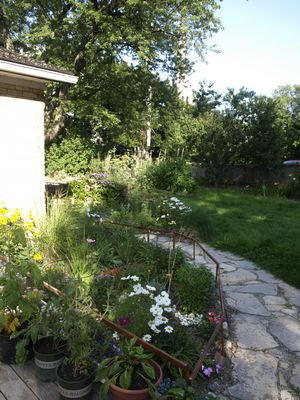
Iceland: some numbers
18 days
11 hotels or guesthouses
1 ridiculously hard bed
10 otherwise just ordinary hard beds
0 "soft enough" beds
0 incidences of salt and vinegar chips
At least a dozen incidences of searching grocery stores for said chips - Karen lived in hope
1 incidence, purely by the kindness of a charming waiter, of
vinegar made available for french fries
7 completely new food experiences - puffin, whale, reindeer,
hakarl, langoustine, monkfish and liquid nitrogen
5 hours. Until the very last night here, that was the longest
consecutive sleep Karen achieved in a country with this much sun in the
summer. On the last night here, she almost got 7 hours!
5 hours on the plane
4 hours ahead in time difference.
0 natural disasters - last year you see, there was this earthquake but no repeats this year.
1 incidence of whale watching that resulted in 0 whales spotted and
3 hours of vomiting
1.5 Canadian lanes wide - that's how large Icelandic 2 lane roads are in the West Fjörðs, largely unpaved and
often steep and blind which makes driving rather interesting.
1 billion waterfalls encountered
2 volcano encounters - Krafla and Hekla
1 glacier - in a manner of speaking
1 billion museums or 'centres'
Dozens and dozens of dirty brown rags categorized and photographed
2070 photographs taken
18 days in Iceland? Priceless!
Questions? We'd be happy to answer. petersons@treheima.ca




























































































